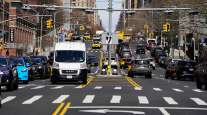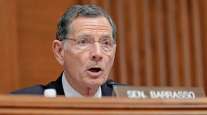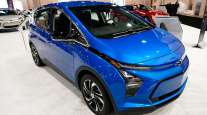Eugene Mulero
| Senior Reporter
How Do the Candidates’ Infrastructure Plans Compare?
Use this grid to compare the infrastructure plans of the candidates who are running for president in 2020.
| Name | What's the plan? | What are the funding details? | How would it be paid for? | How many jobs would it create? | How would it impact freight? | Quote | Video |
|---|---|---|---|---|---|---|---|
 |
 The Biden Plan to Invest in Middle Class Competitiveness |
The 10-year, $1.3 trillion plan would dedicate $50 billion during his administration’s first year on fixing highways and bridges, as well as dedicate $5 billion over five years to electric vehicle batteries. It also would dedicate $400 billion over a decade for research and innovation of clean energy, provide $3.5 billion for infrastructure grants, provide $20 billion for rural broadband; allocate $100 billion to modernize schools and establish a $40 billion, 10-year Transformational Projects Fund. It would dedicate $5 billion for states to promote small businesses. TT story | Reversing the Tax Cuts and Jobs Act of 2017 anchors the plan’s source of funding. On the looming insolvency of the Highway Trust Fund, the plan indicated new revenues would be secured. | The plan would direct the U.S. Department of Transportation to work with unions to connect individuals with employment in automation. Also, the plan claimed millions of jobs would be created through a transition to a clean energy economy. | Rebuilding freight corridors is designed to improve delivery times. Vast reductions in emissions standards would target the trucking industry. Modernizing ports is meant to enhance last-mile operations. | “That $1.9 trillion that Trump gave away to the top 2%, we’re going to invest in families instead.” — Feb. 11, 2020 | |
 |
 Mike Bloomberg's infrastructure plan |
The $1 trillion-plus plan proposes $30 billion for a highway funding program; $12 billion in a new operating assistance program; allocate funds to transition to pollution-free electric vehicles. TT story | A sustainable source of funding for highway programs is absent in the plan. | The creation of millions of jobs is promised through construction projects, as well as labor protections under Davis-Bacon/Buy American. Low-income and minority communities would be targeted for apprenticeships and training programs. | A proposal to jump-start electrification of ports and freight hubs has the potential of revolutionizing the industry. | “Donald doesn’t want to run against me because he knows I know what he’s done. I know how to take him on.” — Feb. 3, 2020 | |
 (dropped out March 1) |
 |
The plan would dedicate $10 billion to recruit and train employees; provide $100 million to expand apprenticeships, invest $10 billion in drinking water programs, provide $10 billion to assist with wastewater treatment; allocate $2 billion for infrastructure grants; dedicate more than $160 billion for public transportation; establish a $50 billion grant program to repair bridges; and provide $1.5 billion for climate and flood resilience programs. TT story | For highway programs, the plan proposes an injection of $165 billion into the Highway Trust Fund to ensure its solvency through 2029. During that time, the administration would press DOT to advance a sustainable source of funding, such as a fee on vehicle miles traveled. |
About 6 million jobs are projected through investments in clean energy. Support of the Davis-Bacon Act would ensure fair wages. | Investments in roadway connectivity aimed at minimizing congestion could lead to the quicker movement of freight. Modernizing last-mile delivery segments would enhance efficiency. | “So many communities, communities like mine in South Bend, we know that we might look small from the perspective of Washington. But to us, it’s what’s going on in Washington that looks so small and small-minded.” — Feb. 9, 2020 | |
 |
Tulsi Gabbard on Infrastructure |
Besides recognizing funding woes for infrastructure programs, a funding plan is not outlined. | The candidate lists related legislation backed primarily via direct federal funds. An overall pitch is missing. | Not provided. | Insufficient information. | “My goal has never been to be queen of the Democratic establishment.” — Jan. 12, 2019 | |
 (dropped out March 2) |
 Amy's Plan to Build America's Infrastructure |
The $1 trillion plan would dedicate $650 billion in federal funding for infrastructure projects. Under her administration, funds in the Harbor Maintenance Trust Fund would be dedicated for harbor projects. TT story | Without offering specifics, the plan indicates it would stabilize the Highway Trust Fund. It would seek to establish a nonpartisan Infrastructure Financing Authority to assist local governments with accessing private funds. | Jobs would be created, through expanding access to broadband and boosting the construction sector, according to the plan. | An overhaul to freight rail is proposed. Enhancing the climate resilience of transportation networks has the potential of ensuring freight corridors are not destroyed after severe weather events. | “Hello America. I’m Amy Klobuchar, and I will beat Donald Trump.” — Feb. 12, 2020 |
|
 |
 The Green New Deal |
A climate-centric Green New Deal plan calls for dedicating $16.3 trillion for a transformation of the transportation system. That proposal also calls for dedicating $200 billion to a Green Climate Fund. | Specificity on sources of funding have not been publicized. | A solution to the climate change crisis would necessitate 20 million jobs, according to the climate-centric plan. | Major reforms to fuel emission standards would undoubtedly lead to certain costs industrywide. Modernizing major corridors would improve freight connectivity. | “We are taking on the establishment.” — Feb. 12, 2020 | |
(dropped out Feb. 29) |
Infrastructure Investment at a Glance |
The plan would dedicate $2 trillion of public investment for “climate-smart” infrastructure. A clean-transportation network would be backed by $775 billion. To achieve “climate smart” walkable communities, $555 billion would be provided, and to repair roadways, bridges and levees, $450 billion would be proposed. | Public investments would ideally “mobilize” more than $6 trillion. | A “justice-centered” climate change-centric plan associated with an infrastructure policy pitch would lead to 46 million jobs in about a decade. | Vast changes to the freight ecosystem would lead to various degrees of disruptions industrywide. Changes to emissions standards, for instance, would demand quick action from key sectors. | “I really believe in people being on the ground, the candidate being on the ground and seeing people face to face.” — Feb. 16, 2020 | |
Historic Investment in America's Infrastructure |
A 10-year, $810 billion highway-centric policy plan along with a $190 billion proposal for water improvement projects and rural broadband access, for instance, anchor the incumbent’s $1 trillion plan. | The president’s transportation team indicated on Feb. 10 those funding plans would be revealed in the coming months. | Job creation figures are not specified. The president, however, has insisted modernization projects would create new jobs. | There would be $50 billion dedicated for a “Moving America’s Freight Safely and Efficiently” program backed by formula and discretionary grants. | “You just look at the way our country is doing. We’ve never done as well as we’re doing right now.” — Feb. 9, 2020 | ||
My Plan to Create 10.6 Million Green Jobs |
The plan would propose public and private investments totaling $10.7 trillion for a clean energy economy, which would entail transforming basic infrastructure nationwide. A $200 million annual investment would back apprenticeship programs, and $50 billion would target improvements to schools. | The availability of “Green Victory Bonds” would finance the process of transitioning toward a green economy. | About 10.6 million jobs would be created. | The complete modernization of the transportation landscape would require the freight industry to update equipment and adapt to different landscapes. | “I believe in grassroots funding.” — Feb. 14, 2020 |




